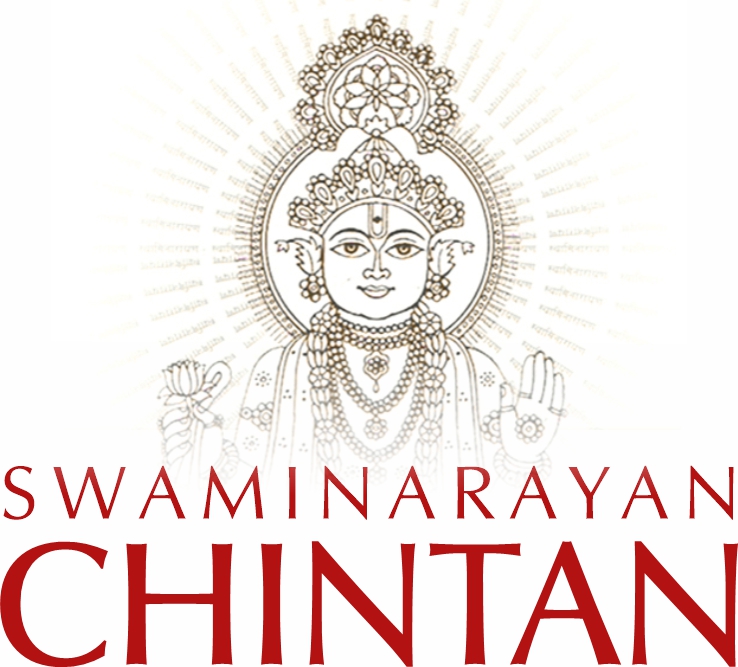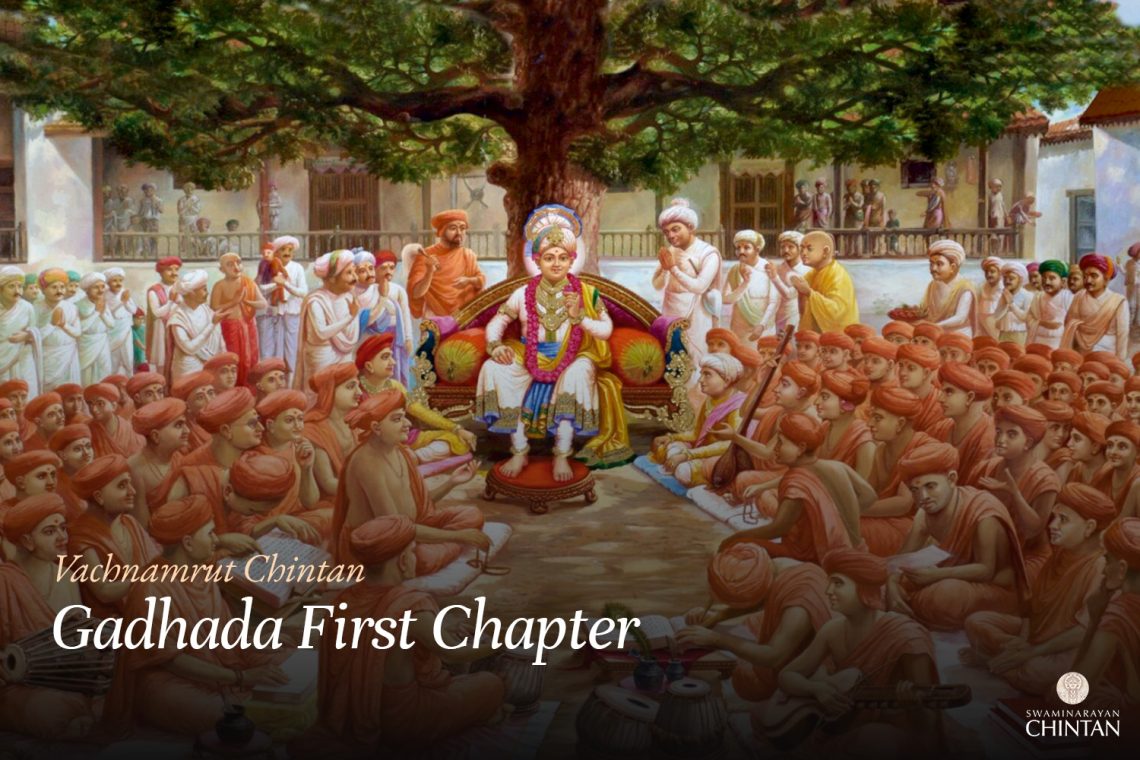Central Insights:
- Practice meditation. Diligently.
Key Points:
Even if God’s divine Murti (form/image) is not visualised, a devotee must always remain persistent and meditate enthusiastically upon the Murti of God.
Explanation
Here Shreeji Maharaj ordains His devotees to meditate on the divine Murti of Lord Shree Krishna along with Rādhikāji. This order creates many debates because Satsaṅgis (members of holy fellowship) are inclined to meditate upon the divine Murti of Shreeji Maharaj instead of other deities. So when they read this Vachanāmrut, people question: should they meditate on the divine image of Shreeji Maharaj or Lord Shree Krishna along with Rādhikāji?
This discourse places a significant emphasis on ardent meditation; therefore, when this discussion was written, earlier saints were quick to classify this as the Vachanāmrut on the “Persistence of Meditation” instead of “Meditation of Lord Shree Krishna along with Rādhikāji.” This distinction is crucial because it becomes the foundation of this discourse. Shreeji Maharaj wanted to stress the importance of meditation instead of emphasising the Murti of Lord Shree Krishna along with Rādhikāji. This is evident in the last statements of the Vachanāmrut, where Shreeji Maharaj says, “God favours devotees who are persistent in engaging their minds in meditation.” Here, a meditation on Lord Shree Krishna along with Rādhikāji is not emphasised; instead, it emphasises meditation.
Though the Murti of God is not visualised, do not stop the meditation cowardly or bored; continue to show persistence.
करत करत अभ्यास ते जडमति होत सुजान
karata karata abhyāsa te jaḍamati hota sujāna
Even if the image of God may not be visualised with persistent meditation and devotion, devotees should patiently and repeatedly try without losing heart. Meditation is not easy. The mind is plagued with thousands of thoughts that pose a tremendous distraction. The Yog Sutra defines meditation as:
स तु दीर्घकालनैरन्तय् सत्कारासेवितो द्रढभूमिः ( समाधि पाद :१४ )
sa tu dīrghakālanairantay satkārāsevito draḍhabhūmiḥ ( samādhi pāda :14 )
Meditation, though extremely difficult, must be pursued with devotion and patience without regularly losing heart; if that does not happen. To do this, one must daily practice meditation with increased concentration and duration. If practised religiously and earnestly, Dhyān needs to be sustained for more than a couple of minutes. This will lead to an increased relationship with God, who then in return, showers His devotee with many blessings.
The Vachanāmrut mentions meditating on the Murti of Lord Shree Krishna along with Rādhikāji’. It was discussed above and has been dealt with in the Shikshāpatri, Satsaṅgijivan, a few discourses across the Vachanāmrut and other scriptures of the holy fellowship. So, it would not be incorrect if we discuss the same here.
With a cautious study and keeping all the principles of Vachanāmrut in mind, it can be concluded that Maharaj has emphasised meditation on Shree Nārāyan as the most important in the Vachanāmrut. In the Vach.L.11 Shreeji Maharaj mentions that, “Moreover one should meditate upon the Murti he has got and not upon the images of His other incarnations. One should be determined to serve the mūrti which is with him. He should serve the image as a faithful, devoted wife.” Comparing the current discussion with Vach.L.11, a contradiction is developed. Should a Satsaṅgi meditate on the Divine Murti of Shreeji Maharaj or the Divine Murti of Lord Shree Krishna along with Rādhikāji? The Slokas (verses) 109 to 112 in the Shikshapatri have mentioned the Upāsya Tatva (the worshipable element-God) only.
This is followed by a description of the various forms of Shree Krishna Bhagwan, i.e. Nar Nārāyan (Krishna and Arjun), Laxminārāyan (Krishna along with Rukshamaniji), Balbhadra (Balaram and Krishna) and Radhakrishna (Krishna along with Rādhikāji). And those devotees such as Arjun at times reside by His side and sometimes dissolve in the Murti of God and at times remain in the service of God. Yet this does not add up anything to the form of God. Because all those forms because the Upāsya Tatva or element is Nārāyan only and not devotees such as Arjun, Rādhikāji, Lakshmiji or any other devotees. It is also mentioned that God is dwibhuj (having two hands). Furthermore, Sloka number 113 describes
तस्यैव सर्वथा भक्तिः कर्तव्या मनुजैर्भुवि ( शिक्षापत्री : ११३ )
tasyaiva sarvathā bhaktiḥ kartavyā manujairbhuvi ( śikṣāpatrī : 113 )
Where the word Tasya (his) is used, if devotees like Arjun etc., have been in the Upāsya Tatva, then Shreeji Maharaj would have used tayoh (both of them) or teshām (all of them) instead. In the above topic of Upasana, Shreeji Maharaj has neither used the word tayoh (both of them) nor teshām (all of them). Thus, only the Nārāyan Tatva appears to be the Murti of the God for Upāsana conclusively.
Furthermore, Rādhikāji, Lakshmiji, or Nar have not been mentioned in any spiritual book such as the Brahma Sutras, Bhagawad Gita and Upanishads. The Gita portrays only Nārāyan Tatva. Hence only Nārāyan is found in Upāsya Kakshā. In Vach.L.14 Maharaj mentions His Upāsnā as one where He forever sees Lord Nārāyan with an aura of radiating brilliance, surrounded by immeasurable and infinite value? At the centre of the aura resides the splendid and Divine Murti of Lord Nārāyan seated in a gorgeous throne surrounded by innumerable devotees that have attained salvation.
Here, Shreeji Maharaj has not mentioned the presence of either Laxminārāyan Dev or Naranārāyan Dev on the throne. However, scriptures like the Vachanāmrut and Gita advocate Lord Nārāyan being the centre of Upāsana.
Here the question arises: why have Acharyas recommended devotion towards Radhakrishna, Laxminārāyan and Naranārāyan? What can be the reason behind this?
The answer is that the Sanatan Dharma is disseminated into five categories.
- Shānta (Calm/Cool)
- Dāsya (Conceding)
- Sakhya (Friend)
- Vātsalya (Affection/Love)
- Mādhurya (Kindness)
These five streams are expanded forms of devotion as per Sanātan Dharma.
- Devotion like Rishi-Munis who worship through Dhyān – a cool, calm and collective mind
- Devotion like Shri Hanuman, Garuda and Nand Santos (saints on earth during the period of Shreeji Maharaj) worship through Bhakti Yog i.e. worship of God through devotional service as humble servants.
- Sakhya worship is Nistha (faith in God), Seva (service) accompanied with the end of hesitation with God i.e. friendship. Examples are Sura Khāchar, Sadguru Brahmānand Swami.
- Along with the Nisthā and Sevā, My-ness – sentiments of paternity are found in Vātsalya. Examples are Dharmadev-Bhaktidevi, Nanda-Yashoda, and Vasudev-Devki. Aspiration, holy intentions and passion stop when lust arises within the mind. God has created lust in the hearts of every human. So, using this inherent love and affection (Mādhurya-bhav) to attach to God is the best solution for people. The ideal spiritual guide for this devotion/worship is Rādhikāji.
- Devotion through Nisthā (faithfulness), Sevā, my-ness and above all surrendering one’s own self is found in mādhurya. Examples are Rādhikāji.
It has been stated in scriptures that
कामिनी जिज्ञासा सर्व जिज्ञासा प्रतिबंधिनी
kāminī jijñāsā sarva jijñāsā pratibaṃdhinī
the desire for women obstructs all other inquiries. When such desires arise in a person’s heart, they hinder all noble aspirations, yearnings, and virtuous goals. This is how Bhagwan has structured the hearts of all beings.
Among the various forms of devotion, madhurya-bhava (devotion imbued with divine sweetness) enables one to become most engrossed in Bhagwan. No other devotional sentiment allows for such complete absorption. Radhikaji is the foremost exponent of madhurya-bhava, and this sentiment, when directed toward Bhagwan, is purely divine—it bears no trace of worldly shringara-ras (romantic love). Thus, Radhikaji is the supreme ideal of this devotion.
Additionally, Radhikaji, Lakshmiji, and Bhagwan Nar are exemplars of the proper way to offer devotion to Bhagwan. They are not objects of Upasana, but their method of devotion serves as the ideal to be followed. Therefore, as per the teachings of Maharaj and the great acharyas, the conclusion is clear: the sole upasya (worshippable deity) is Bhagwan Narayan, while Radhikaji and others stand as symbols of how devotion should be performed with intense love and dedication.
This principle is evident even in temples, where these great devotees are depicted in the posture of servitude (sevak-bhav). This symbolism has been consistently observed in all scriptural and devotional traditions.
Glossary
| Bhagavad Gita – Sacred Vedic Scripture A dialogue between Shree Krishna and Arjuna that contains spiritual and philosophical teachings. |
| Bhakti Yoga – The path of devotion to God Shreeji Maharaj emphasizes Bhakti Yoga as the supreme means to please God. Even if one lacks other attributes like vairagya or gyan, deep devotion (bhakti) with God’s mahima (glory) leads to liberation. |
| Brahma Sutras – Essence of Upanishads A Vedic text that defines the attributes and greatness of God. |
| Dasya Bhava – The sentiment of servitude One worships God as a humble servant, like Hanuman or Garudji, with complete submission and devotion through service. |
| Dhyan – Meditation Deep concentration on Bhagwan’s divine form. |
| Dwibhuj – Two-armed form The form of Bhagwan Narayan depicted with two arms. |
| Madhurya Bhava – The sentiment of romantic love (divine conjugal mood) where the soul offers itself to God as a beloved; includes complete surrender and emotional intimacy like Radhikaji. |
| Murti – Divine form of God Refers to Bhagwan’s physical or imagined divine form, which provides joy and spiritual connection during contemplation. |
| Sakhya Bhava – The sentiment of friendship Worship marked by affection and familiarity with God, without fear, like a friend—free of formality and filled with trust. |
| Sanatan Dharma – Eternal Religion The original and eternal path of righteousness in Hinduism. |
| Satsangijivan – The Sacred Scripture of Swaminarayan Sampraday The sacred Text that depicts the divine pastimes of Bhagwan Swaminarayan and describes the Dharma of saints and satsangis. |
| Satsangis – Devotees of Bhagwan Swaminarayan Those engaged in the holy fellowship of Bhagwan Swaminarayan following Panch Vartman & Niyams of Swaminarayan Sampraday |
| Sevak-Bhav – Servant-like attitude A mindset of humility and devotion to Bhagwan, considering oneself as a servant. |
| Shanta Bhava – The sentiment of peacefulness and detachment A devotee worships God with tranquility, free from worldly agitation, similar to ancient rushi who remained calm and contemplative. |
| Shikshapatri – Sacred Scripture of Swaminarayan sect written by Bhagwan Swaminarayan Himself containing Essence of all the Vedic Scriptures |
| Upanishads – Ancient Vedic Scriptures Philosophical texts explaining the ultimate truth about God and the soul. |
| Upasana – Worship and devotion Worship and devotion with the attitude of serving Bhagwan as one’s supreme master |
| Upasya Tatva – Worshipable Element The essential divine element/God worthy of worship. |
| Vachanamrut – Scriptural text containing Bhagwan Swaminarayan’s Teachings A sacred scripture that contains Bhagwan Swaminarayan’s discourses and teachings, offering guidance on spiritual practices, devotion, and moral living. |
| Vatsalya Bhava – The sentiment of parental affection Devotees love God as a parent loves a child, with protectiveness and nurturing affection, like Nand or Yashoda towards Krishna. |

